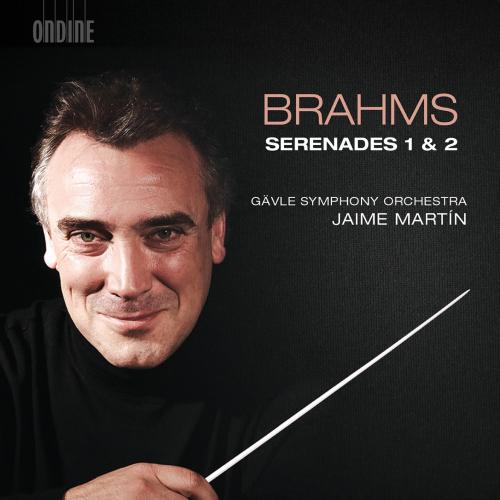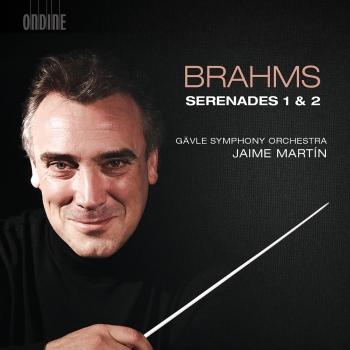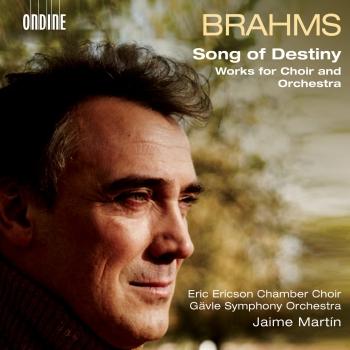
Brahms: Serenades Nos. 1 & 2 Gävle Symfoniorkester & Jaime Martín
Album info
Album-Release:
2017
HRA-Release:
11.05.2017
Label: Ondine
Genre: Classical
Subgenre: Orchestral
Artist: Gävle Symfoniorkester & Jaime Martín
Composer: Johannes Brahms (1833-1897)
Album including Album cover
- Johannes Brahms (1833-1897): Serenade No. 1 in D Major, Op. 11:
- 1 I. Allegro molto 12:53
- 2 II. Scherzo. Allegro non troppo 07:18
- 3 III. Adagio non troppo 11:07
- 4 IVa. Menuetto I 01:25
- 5 IVb. Menuetto II 01:38
- 6 IVc. Coda 01:01
- 7 V. Scherzo. Allegro 02:34
- 8 VI. Rondo. Allegro 05:45
- Serenade No. 2 in A Major, Op. 16:
- 9 I. Allegro moderato 07:46
- 10 II. Scherzo. Vivace 02:52
- 11 III. Adagio non troppo 07:33
- 12 IV. Quasi menuetto 04:42
- 13 V. Rondo. Allegro 05:59
Info for Brahms: Serenades Nos. 1 & 2
This Ondine recording is the first instalment in a series of Brahms recording with the Gävle Symphony Orchestra and their chief conductor Jaime Martín. Together with the orchestra Martín offers delightful interpretations of these two early examples of Brahms’ orchestral writing.
Jaime Martín became the Artistic Director and Principal Conductor of Gävle Symphony Orchestra in 2013. During recent years orchestral engagements have led the rising conductor to collaborate with several prominent orchestras around the world. Martín is also Chief Conductor of the Orquestra de Cadaqués and known for his active career as solo flautist.
Johannes Brahms’ (1833–1897) two orchestral Serenades were written in the late 1850s and together with the 1st Piano Concerto offer the earliest surviving examples of his orchestral writing. Brahms revised the 1st Serenade several times, and intended “to transform the 1st Serenade into a symphony”. The 6 movement work, originally titled as Nachtmusik, is an impressive poetic creation by the young composer.
Serenade No. 2 has an unusual chamber-music setting: double woodwinds, two horns and a string ensemble that entirely omits the bright sound of violins and instead deploys the violas as the principal part. The second Serenade has somewhat remained in the shadow of the popularity of the 1st Serenade. However, Clara Schumann, who received the Adagio and Menuett-Trio as a birthday present, responded with enthusiasm to the new work. She described the Adagio as “something ecclesiastical”, “it could be an Eleison”, and admitted in her accompanying letter returning the score: “With the Adagio I part with the greatest difficulty, as it is very dear to me.”
Gävle Symphony Orchestra, founded in Sweden in 1912, has a long and exciting history. Since 2013, the orchestra has enjoyed a fruitful musical partnership with principal conductor Jaime Martín, but the orchestra has also collaborated regularly with renowned international conductors. The orchestra has also started a collaboration with the Eric Ericson Chamber Choir leading to a recording of Johannes Brahms’ Cantatas for choir and orchestra to be released by Ondine.
“[a] characterful, lucid and glowingly affectionate pair of performances. Martín chooses sensible speeds, possesses a keen ear, and elicits a thoroughly tasteful, poised and eager response from his colleagues…most enjoyable!” (Classical Ear)
“I like the Gävle strings’ trenchant leap into the development section, and they maintain a fine control of those oscillating figures …Jaime Martín is not seeking hidden depths in the Adagio, which flows in unaffected fashion…it’s a disc to raise the spirits” (Gramophone Magazine)
"...This is a truly fine issue, of which the artists and the company which has served them so well should feel justly proud. It is comprehensively recommended to all Brahms lovers and to those keen to hear great music well performed and presented." (Robert Matthew-Walker, Musical Opinion Quarterly)
"This release marks the start of a Brahms cycle from this fine orchestra and its relatively recent principal conductor, and these are vibrant, gutsy readings of the two 'pre-symphonies'... there is no denying the power of these readings. In fact that momentum suits the less well-known second serenade, which comes across as the more memorable." (Guy Weatherall, Classical Music magazine)
Gävle Symphony Orchestra
Jaime Martín, conductor
The Gävle Symphony Orchestra
founded in 1912, has a long and exciting history, but its focus is always on the future. Each concert presents an opportunity to deliver the very best, and to meet the expectations of the audience for an artistic experience at the highest level.
The orchestra has since its inception played an obvious and significant role in the Swedish music scene and its 52 musicians are driven by an undeniable and heartfelt passion for music. The orchestra takes on a repertoire ranging from the baroque to the latest contemporary music with equal curiosity and dedication. It is of particular note that the orchestra’s initiatives with composers-in-residence have provided a vivid image of the outside world. Through a series of acclaimed CD recordings, the Gävle Symphony Orchestra has also brought many older Swedish composers into the limelight and given them well-deserved recognition.
Since 2013, Gävle Symphony Orchestra has enjoyed a fruitful musical partnership with principal conductor Jaime Martín and the orchestra has also collaborated regularly with renowned conductors such as Leif Segerstam and the late Sir Neville Marriner. Among returning soloists you find stars Isabelle van Keulen, François Leleux, Gabriela Montero and many others. During Jaime Martín’s tenure as principal conductor, the Gävle Symphony Orchestra has also started a collaboration with the Eric Ericson Chamber Choir.
Jaime Martín
has risen quickly to international acclaim as a conductor following his prominent career as a flautist. In 2013 he became Artistic Director and Principal Conductor of Gävle Symphony Orchestra and he is also Chief Conductor of the Orquestra de Cadaqués and Artistic Director of the Santander International Festival.
As a guest conductor Martín has worked extensively with orchestras throughout the UK and Ireland, including the London Philharmonic Orchestra, Philharmonia Orchestra, Royal Scottish National Orchestra, Academy of St. Martin in the Fields, London Mozart Players, BBC Symphony Orchestra, the Ulster Orchestra and RTE Orchestra. He has also conducted the Orchestre Philharmonique de Radio France, Royal Liverpool Philharmonic Orchestra, Swedish Radio Symphony Orchestra, Saint Paul Chamber Orchestra, New Zealand Symphony Orchestra, Queensland Symphony Orchestra, Orquestra Sinfônica do Estado de São Paulo, Lausanne Chamber Orchestra, National Orchestra Lyon, Beijing Symphony Orchestra, Winterthur Orchestra, Orquestra Sinfònica de Barcelona and the Royal Flemish Philharmonic. He made his debut at the English National Opera in February 2013 conducting Barber of Seville and returned in autumn 2014 to conduct Marriage of Figaro.
Previous recordings include Schubert’s Symphony No. 9, Montsalvatge’s Petita Suite Burlesca, Halffter’s Sinfonietta and Beethoven’s Symphony No. 3 “Eroica” with the Orquestra de Cadaqués for Tritó. Solo recordings include Mozart concertos with Sir Neville Marriner, a premiere recording of the Sinfonietta Concerto for Flute and Orchestra written for him by Xavier Montsalvatge and conducted by Gianandrea Noseda, Bach works for flute, violin, and piano with Murray Perahia and the Academy of St. Martín in the Fields for Sony Classical.
This album contains no booklet.











